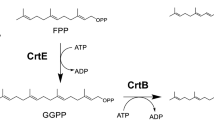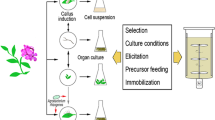Abstract
Phloretin is an important skin-lightening and depigmenting agent from the peel of apples. Although de novo production of phloretin has been realized in microbes using the natural pathway from plants, the efficiency of phloretin production is still not enough for industrial application. Here, we established an artificial pathway in the yeast to produce phloretin via assembling two genes of p-coumaroyl-CoA ligase (4CL) and chalcone synthase (CHS). CHS is a key enzyme which conventionally condenses a CoA-tethered starter with three molecules of malonyl-CoA to form the backbone of flavonoids. However, there was 33% of by-product generated via CHS by condensing two molecules of malonyl-CoA during the fermentation process. Hence, we introduced a more efficient CHS and improved the supply of malonyl-CoA through two pathways; the by-product ratio was decreased from 33% to 17% and the production of phloretin was improved from 48 to 83.2 mg L−1. Finally, a fed-batch fermentation process was optimized and the production of phloretin reached 619.5 mg L−1, which was 14-fold higher than that of the previous studies. Our work established a platform for the biosynthesis of phloretin from the low-cost raw material 3-(4-hydroxyphenyl) propanoic acid and also illustrated the potential for industrial scale bio-manufacturing of phloretin.
Similar content being viewed by others
References
Abe, I., Morita, H., Nomura, A., and Noguchi, H. (2000). Substrate specificity of chalcone synthase: enzymatic formation of unnatural polyketides from synthetic cinnamoyl-CoA analogues. J Am Chem Soc 122, 11242–11243.
Austin, M.B., and Noel, J.P. (2003). The chalcone synthase superfamily of type III polyketide synthases. Nat Prod Rep 20, 79–110.
Bai Flagfeldt, D., Siewers, V., Huang, L., and Nielsen, J. (2009). Characterization of chromosomal integration sites for heterologous gene expression in Saccharomyces cerevisiae. Yeast 26, 545–551.
Behzad, S., Sureda, A., Barreca, D., Nabavi, S.F., Rastrelli, L., and Nabavi, S.M. (2017). Health effects of phloretin: from chemistry to medicine. Phytochem Rev 16, 527–533.
Bi, H., Bai, Y., Cai, T., Zhuang, Y., Liang, X., Zhang, X., Liu, T., and Ma, Y. (2013). Engineered short branched-chain acyl-CoA synthesis in E. coli and acylation of chloramphenicol to branched-chain derivatives. Appl Microbiol Biotechnol 97, 10339–10348.
Chen, Y., Bao, J., Kim, I.K., Siewers, V., and Nielsen, J. (2014). Coupled incremental precursor and co-factor supply improves 3-hydroxypropionic acid production in Saccharomyces cerevisiae. Metab Eng 22, 104–109.
Cole, S.T., Brosch, R., Parkhill, J., Garnier, T., Churcher, C., Harris, D., Gordon, S.V., Eiglmeier, K., Gas, S., Barry Iii, C.E., et al. (1998). Deciphering the biology of Mycobacterium tuberculosis from the complete genome sequence. Nature 393, 537–544.
de Jong, B.W., Shi, S., Valle-Rodríguez, J.O., Siewers, V., and Nielsen, J. (2015). Metabolic pathway engineering for fatty acid ethyl ester production in Saccharomyces cerevisiae using stable chromosomal integration. J Ind Microbiol Biotechnol 42, 477–486.
Duan, L., Ding, W., Liu, X., Cheng, X., Cai, J., Hua, E., and Jiang, H. (2017). Biosynthesis and engineering of kaempferol in Saccharomyces cerevisiae. Microb Cell Fact 16, 165.
Eichenberger, M., Lehka, B.J., Folly, C., Fischer, D., Martens, S., Simón, E., and Naesby, M. (2017). Metabolic engineering of Saccharomyces cerevisiae for de novo production of dihydrochalcones with known antioxidant, antidiabetic, and sweet tasting properties. Metab Eng 39, 80–89.
Espín, J.C., Varón, R., Fenoll, L.G., Gilabert, M.A., García-Ruíz, P.A., Tudela, J., and García-Cánovas, F. (2000). Kinetic characterization of the substrate specificity and mechanism of mushroom tyrosinase. Eur J Biochem 267, 1270–1279.
Gibson, D.G., Young, L., Chuang, R.Y., Venter, J.C., Hutchison Iii, C.A., and Smith, H.O. (2009). Enzymatic assembly of DNA molecules up to several hundred kilobases. Nat Methods 6, 343–345.
Gietz, R.D., Schiestl, R.H., Willems, A.R., and Woods, R.A. (1995). Studies on the transformation of intact yeast cells by the LiAc/SS-DNA/PEG procedure. Yeast 11, 355–360.
Gosch, C., Halbwirth, H., Kuhn, J., Miosic, S., and Stich, K. (2009). Biosynthesis of phloridzin in apple (Malus domestica Borkh.). Plant Sci 176, 223–231.
Gosch, C., Halbwirth, H., and Stich, K. (2010). Phloridzin: biosynthesis, distribution and physiological relevance in plants. Phytochemistry 71, 838–843.
Hohmann, S. (1987). A region in the yeast genome which favours multiple integration of DNA via homologous recombination. Curr Genet 12, 519–526.
Jiang, H., Wood, K.V., and Morgan, J.A. (2005). Metabolic engineering of the phenylpropanoid pathway in Saccharomyces cerevisiae. Appl Environ Microbiol 71, 2962–2969.
Johnson, A.O., Gonzalez-Villanueva, M., Wong, L., Steinbüchel, A., Tee, K.L., Xu, P., and Wong, T.S. (2017). Design and application of genetically-encoded malonyl-CoA biosensors for metabolic engineering of microbial cell factories. Metab Eng 44, 253–264.
Krivoruchko, A., and Nielsen, J. (2015). Production of natural products through metabolic engineering of Saccharomyces cerevisiae. Curr Opin Biotech 35, 7–15.
Leonard, E., Yan, Y., Fowler, Z.L., Li, Z., Lim, C.G., Lim, K.H., and Koffas, M.A.G. (2008). Strain improvement of recombinant Escherichia coli for efficient production of plant flavonoids. Mol Pharm 5, 257–265.
Li, S., Ding, W., Zhang, X., Jiang, H., and Bi, C. (2016). Development of a modularized two-step (M2S) chromosome integration technique for integration of multiple transcription units in Saccharomyces cerevisiae. Biotechnol Biofuels 9, 232.
Liu, X., Cheng, J., Zhang, G., Ding, W., Duan, L., Yang, J., Kui, L., Cheng, X., Ruan, J., Fan, W., et al. (2018). Engineering yeast for the production of breviscapine by genomic analysis and synthetic biology approaches. Nat Commun 9, 448.
Liu, X., Ding, W., and Jiang, H. (2017). Engineering microbial cell factories for the production of plant natural products: from design principles to industrial-scale production. Microb Cell Fact 16, 125.
Maassen, N., Freese, S., Schruff, B., Passoth, V., and Klinner, U. (2008). Nonhomologous end joining and homologous recombination DNA repair pathways in integration mutagenesis in the xylose-fermenting yeast Pichia stipitis. FEMS Yeast Res 8, 735–743.
Milke, L., Aschenbrenner, J., Marienhagen, J., and Kallscheuer, N. (2018). Production of plant-derived polyphenols in microorganisms: current state and perspectives. Appl Microbiol Biotechnol 102, 1575–1585.
Pandey, R.P., Parajuli, P., Koffas, M.A.G., and Sohng, J.K. (2016). Microbial production of natural and non-natural flavonoids: pathway engineering, directed evolution and systems/synthetic biology. Biotech Adv 34, 634–662.
Petersen, C. (1835). Analyse des phloridzins. Annalen der Pharmacie 15, 178–178.
Rana, S., and Bhushan, S. (2016). Apple phenolics as nutraceuticals: assessment, analysis and application. J Food Sci Technol 53, 1727–1738.
Reider Apel, A., d’Espaux, L., Wehrs, M., Sachs, D., Li, R.A., Tong, G.J., Garber, M., Nnadi, O., Zhuang, W., Hillson, N.J., et al. (2016). A Cas9-based toolkit to program gene expression in Saccharomyces cerevisiae. Nucleic Acids Res 45, 496–508.
Salem-Bekhit, M.M., Bayomi, M., Al-Anazi, F., and Radawan, H. (2013). Yield production of recombinant plasmid DNA with Escherichia Coli in fed-batch culture by pseudo-exponential feeding. Biotechnol Biotec Eq 27, 3709–3715.
Schiestl, R.H., and Gietz, R.D. (1989). High efficiency transformation of intact yeast cells using single stranded nucleic acids as a carrier. Curr Genet 16, 339–346.
Shao, Z., Zhao, H., and Zhao, H. (2008). DNA assembler, an in vivo genetic method for rapid construction of biochemical pathways. Nucleic Acids Res 37, e16.
van Gelder, C.W.G., Flurkey, W.H., and Wichers, H.J. (1997). Sequence and structural features of plant and fungal tyrosinases. Phytochemistry 45, 1309–1323.
van Rossum, H.M., Kozak, B.U., Pronk, J.T., and van Maris, A.J.A. (2016). Engineering cytosolic acetyl-coenzyme A supply in Saccharomyces cerevisiae: pathway stoichiometry, free-energy conservation and redox-cofactor balancing. Metab Eng 36, 99–115.
Wang, Y., Chen, H., and Yu, O. (2014). A plant malonyl-CoA synthetase enhances lipid content and polyketide yield in yeast cells. Appl Microbiol Biotechnol 98, 5435–5447.
Watts, K.T., Lee, P.C., and Schmidt-Dannert, C. (2004). Exploring recombinant flavonoid biosynthesis in metabolically engineered Escherichia coli. ChemBioChem 5, 500–507.
Werner, S.R., Chen, H., Jiang, H., and Morgan, J.A. (2010). Synthesis of non-natural flavanones and dihydrochalcones in metabolically engineered yeast. J Mol Catal B Enzym 66, 257–263.
Werner, S.R., and Morgan, J.A. (2009). Expression of a Dianthus flavonoid glucosyltransferase in Saccharomyces cerevisiae for whole-cell biocatalysis. J Biotech 142, 233–241.
Wu, K.H., Ho, C.T., Chen, Z.F., Chen, L.C., Whang-Peng, J., Lin, T.N., and Ho, Y.S. (2018). The apple polyphenol phloretin inhibits breast cancer cell migration and proliferation via inhibition of signals by type 2 glucose transporter. J Food Drug Anal 26, 221–231.
Yahyaa, M., Ali, S., Davidovich-Rikanati, R., Ibdah, M., Shachtier, A., Eyal, Y., Lewinsohn, E., and Ibdah, M. (2017). Characterization of three chalcone synthase-like genes from apple (Malus × domestica Borkh.). Phytochemistry 140, 125–133.
Zhao, J., Li, C., Zhang, Y., Shen, Y., Hou, J., and Bao, X. (2017). Dynamic control of ERG20 expression combined with minimized endogenous downstream metabolism contributes to the improvement of geraniol production in Saccharomyces cerevisiae. Microb Cell Fact 16, 17.
Zhou, Y.J., Buijs, N.A., Siewers, V., and Nielsen, J. (2014). Fatty acid-derived biofuels and chemicals production in Saccharomyces cerevisiae. Front Bioeng Biotechnol 2, 32.
Acknowledgements
This work was financially supported by Talents Team Construction Fund of Northwestern Polytechnical University (NWPU) to W. W., the National Natural Science Foundation of China (31701722) and the China Postdoctoral Science Foundation (2017M620471) to C.J., the National Natural Science Foundation of China (31901026) to X.L.
Author information
Authors and Affiliations
Corresponding authors
Ethics declarations
The author(s) declare that they have no conflict of interest.
Electronic supplementary material
Rights and permissions
About this article
Cite this article
Jiang, C., Liu, X., Chen, X. et al. Raising the production of phloretin by alleviation of by-product of chalcone synthase in the engineered yeast. Sci. China Life Sci. 63, 1734–1743 (2020). https://doi.org/10.1007/s11427-019-1634-8
Received:
Accepted:
Published:
Issue Date:
DOI: https://doi.org/10.1007/s11427-019-1634-8




